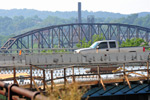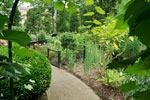
Category Archive: Historic Properties
-
170-Year-Old Tavern in Menallen to Serve Up the Past
By Mary Pickels
TRIBUNE-REVIEW
Thursday, July 22, 2010
Fayette County Historical Society President Jeremy Burnworth is in the restored main room on the second floor of the former Abel Colley Tavern, which will is the society's headquarters. Barry Reeger | Tribune-Review
The Fayette County Historical Society Friday will hold a grand opening of its museum, to be housed in the former Abel Colley Tavern in Menallen.
Open to the public, the 3 p.m. program will showcase the restored red-brick structure at 7083 National Pike.
Last July, Warren and Virginia Dick of Smithfield donated the 170-year-old building to the historical society. Volunteers helped to restore the property, which is listed on the National Register of Historic Places.
Society President Jeremy Burnworth credited volunteer Tom Buckelew and former intern Bill Zinn, along with inmates from the State Correctional Institution at Greene, who performed labor through the Community Works Program, for much of the renovation.
Community volunteers pitched in to paint walls, install moulding and restore hardwood floors.
Although some work remains, the majority of the main rooms have been restored, Burnworth said.
Photos to be displayed Friday will show the “before” and “after,” he said. “You will be able to see (the volunteers’) accomplishments in a short amount of time. We want to let people see the beautiful work that has been done.”
Additional work will help take the structure to its next level, becoming a museum, Burnworth said.
“It’s Fayette County’s first-ever historical museum,” he said. “It’s kind of a big deal.”
Friday’s program will include local government officials, Dick family members and representatives from the National Road Heritage Corridor and the Sen. John Heinz History Center. The historical society is an affiliate of the history center and may benefit in the future through a display of Civil War memorabilia, Burnworth said.
In the future, the site will be used for the society’s headquarters. It will be available for fundraisers and meetings.
Donations of historical artifacts pertaining to Fayette County are welcome.
“They can go way back, 50 to 250 years old,” Burnworth said. “For example, think of veterans.”
There has been no place in the county to display photos, uniforms, letters or furniture, he noted.
“We are afraid people will be throwing things away,” he said. “We really want a situation in place, so even if family members are not interested, we can protect and archive (those items). We get lots of calls for information, requests to come to the building and look at the archives and all of the things people think we have.”
Plans include a gift shop, likely to include publications and books on the region’s history. In acknowledgement of the building’s history, keepsake mugs will be sold on Friday.
Public visitation hours have not been set.
“The committee will help determine the direction of ‘what’s next,'” Burnworth said.
For more information, or to donate or volunteer, visit the society’s website at www.fayettehistory.org. Anyone interested in attending Friday’s opening or joining an advisory committee is asked to call 724-439-4422.
-
Neighbors in the Strip Accredited as a National Main Street Program
Wednesday, July 21, 2010
Pop City Media
Neighbors in the Strip, a non-profit organization dedicated to promoting economic development in the Strip District, has been awarded designation as an accredited National Main Street Program by the National Trust for Historic Preservation.
The prestigious designation is based on a ten point set of criteria, which ultimately demonstrates that an organization has leveraged local historic and business assets to thoroughly promote revitalization of a neighborhood business district.
Neighbors in the Strip was formed in 1999 by stakeholders wishing to better promote economic transformation in the neighborhood, while maintaining its historic character. A decade ago, “the perception of crime in the strip was very high,” notes Becky Rodgers, Executive Director of NITS. “Looking back over the past ten years, with a lot of hard work from the police, the DA’s office, and the stakeholders, crime has decreased in the Strip by 58 percent. If you want to keep economic development happening, you have to keep crime down.”
In addition to making the neighborhood safer, NITS works with local proprietors to promote business. In fact, forty new businesses are scheduled to open soon, including a public market, which will be opening in August.
“We’re mainly zoned urban-industrial in the Strip, which is sort of the wild west of zoning,” says Becky. “So when a new project comes along, there are certain zoning exceptions that have to go in front of the zoning board, and we go with business owners to the board to support those variances.”
Other factors that lead to the Main Street designation include NITS’ strong cooperation with its partners, which include the City, the URA, and a large number of non-profits, as well as the substantial grant programs they offer. Neighbors in the Strip has played a key role in helping the neighborhood evolve into a residential area in the 2000’s, aided by their Upper Floor Grant, which encourages the residential development of underutilized floors above commercial businesses.
Sign up to receive Pop City each week.
Source: Becky Rodgers, Executive Director of Neighbors in the Strip
Writer: John Farley -
Movie Money Spurs Vandergrift Spending Ideas
By Rossilynne Skena and Dale Mann, VALLEY NEWS DISPATCH
Monday, July 19, 2010The borough received $15,000 for opening its streets in June to crews filming “I am Number IV,” an action-packed thriller.
Of the money received from DreamWorks, $5,400 has be allocated to parking meters. There are about 250 parking meters on the borough streets, and those meters need constant updates, council president Brian Carricato said.
The average parking meter costs about $110. Fifty new meters will be purchased and will go into circulation where meters are broken or missing.
Council will vote at its August meeting about how to spend the remaining $9,600.
Carricato would like to see the full sum of the money remaining go toward the recreation committee.
DreamWorks wants to see the money applied to something such as recreation, something the town can look back on in 10 years as an accomplishment, Carricato said.
Typically, he said, recreation is an area where budgets can be cut because other things are more essential.
“There’s not too many times that you do have the opportunity to invest back into your recreation department,” Carricato said.
Christine Wilson, a council member who serves as chairwoman of the budget committee, proposed another plan.
She too would like to see the $5,400 go toward meters, and then allocate $6,500 to codify the borough’s ordinances, which haven’t been updated since 1998. The remaining $3,100 would go to recreation.
Carricato said there’s money in the general fund to use for codifying ordinances.
“We have $42,000 from gas wells in the general fund that should be used for codifying the ordinances,” Carricato said, adding that two more gas wells, located near the Vandergrift Cemetery, will be starting up in the next few weeks.
Wilson said that $20,000 is put into the bank up front for each gas well, and that money is supposed to be used for emergencies.
“I don’t like dipping into that money that we’re putting into the bank for emergency-use only,” Wilson said.
The three operational gas wells brought in more than $25,519.30 for the borough between January and June 30, Borough Secretary Steve DelleDonne said. Wells are located behind the municipal garage, on the Ninth Street Alley above East Vandergrift and on hillside dropping into East Vandergrift, Carricato said.
Wilson disagreed with using any of the gas well funds. Carricato said the money from the gas wells is budgeted into the general fund as anticipated revenue.
Discussion of what to do next was tabled until the next meeting, Wilson said, at which point the recreation committee will bring proposals of how to use the funding.
Carricato and two others recreation committee will meet to discuss ideas, but as for what ideas they have, residents will be in suspense until council meets.
“We’ve already been brainstorming,” Carricato said.
-
Charleroi’s Historic Goaziou Shop to Reopen With Tours, Open House
By Ron Paglia
FOR THE PITTSBURGH TRIBUNE-REVIEW
Sunday, July 18, 2010One of the community’s oldest and most historic buildings will be the focus of attention Monday when the official reopening of The Goaziou Shop is celebrated beginning at noon.
The open house, presented by the Charleroi Area Historical Society, will run until 3:30 p.m. at the site at 807 Fallowfield Ave. and is open to the public. Light refreshments will be served, and tours of the building will be available.
The Goaziou Shop, in Charleroi’s historic district, was the commercial print shop and residence of the late Franco-American Louis Goaziou, a union socialist and main advocate for the North American Co-Masonry movement, for which the first charter was established in Charleroi.
The building, which opened at the turn of the last century, also housed a printing shop owned and operated for many years by Herb Goaziou.
The building’s accommodations for disabled visitors are made available through a grant from the Washington County Tourism and Promotion Agency.
Regular visiting hours at The Goaziou Shop are from 11:30 a.m. to 3:30 p.m. Monday and Friday.
Additional information is available at the historical society’s administration office and the Genealogy and History Research Center at 608 Fallowfield Ave., 724-483-2030, or The Goaziou Shop, 724-483-4961.
-
Firms Pitch Building Plans for Garden Theater Area
By Bill Vidonic
PITTSBURGH TRIBUNE-REVIEW
Tuesday, July 20, 2010The owner of a central North Side business only wanted to hear one issue addressed Monday about the redevelopment of the block surrounding the vacant Garden Theater.
“Parking, parking, parking,” said Irene Karavolos, co-owner of Steve’s New York Hot Dogs on Federal Street. “You can’t bring in more businesses when little businesses already are starving for parking.”
More than 200 people crowded into an auditorium at the Children’s Museum of Pittsburgh to hear several proposals for the block surrounding the former X-rated theater, with five developers promising to spend tens of millions of dollars to revitalize the blighted section of the North Side.
All submitted proposals calling for a mix of retail and residential development; two called for the partial or complete destruction of the vacant Garden Theater auditorium.
Kirk Burkley, president of Northside Tomorrow, which is coordinating redevelopment efforts, said the Garden wouldn’t vanish entirely under any of the proposals. City and national historical designations mean the building’s facade must be preserved.
“This project affects more than just the central North Side,” Burkley said.
North Side resident Matt Long said he’d like to see the Garden restored as an independent filmhouse.
“I don’t think retail would be what I’d put there,” Long said.
Tom Hardy, a consultant with Northside Tomorrow, said a decision could come in the next couple of months.
“We have some momentum now,” Hardy said. “There’s an interest in keeping that momentum going.”
North Side visionsDevelopment proposals for the Garden Theater block:
• Barron Commercial Real Estate, Pittsburgh: Demolish the former Garden Theater auditorium, but preserve and restore the remaining historic properties into a mix of housing and retail development.
• Wells and Company, Spokane, Wash.: Restore the Garden Theater auditorium for a performing arts center; build apartments in the former Masonic building, along with a first-floor restaurant/brew pub; and restore buildings along West North Avenue and Reddour Street.
• Zukin Development Corp., Philadelphia: Create retail space, including a specialty grocery store, by demolishing part of the Garden Theater; create retail space and apartments in the Masonic Hall, the Bradberry apartment building and other properties.
• Aaron Stubna and William Porco, Coraopolis: Convert the Garden into a multi-purpose theater hosting live entertainment and films.
• Resaca LLC, Pittsburgh: Redevelop the Bradberry into 16 one-bedroom apartments.
Source: Northside Tomorrow LLC
-
$17.5 Million for Steel Heritage Sought
dBy Matthew Santoni, PITTSBURGH TRIBUNE-REVIEW
Saturday, July 17, 2010
National heritage park promoters want a ramp built at the Rankin Bridge to provide better access to the former Carrie Furnace (background). Sidney Davis | Tribune-Review
Allegheny County officials are hoping the federal government will invest $17.5 million in a project to turn a former steelmaking site into a national heritage park and build a ramp at the Rankin Bridge to lead visitors to it.
The county, city of Pittsburgh, Port Authority and Port of Pittsburgh Commission are among agencies seeking a share of $600 million in transportation grants that would fund projects to reduce congestion, promote economic activity or improve livability.
At Carrie Furnace, the county wants to build a “flyover” ramp from the interchange at the foot of the Rankin Bridge to carry traffic above four railroad tracks that isolated the former steel mill.
“The (current) access is good for emergency vehicles and some other traffic, but it’s over two sets of active railroad tracks, and you’d have to wind your way back there on a couple of little, local streets,” said Bob Hurley, deputy director of the county’s Department of Economic Development.
The county wants to redevelop 148 acres that once housed the blast furnaces along the Monongahela River in Rankin, part of the former U.S. Steel Homestead Works. The project would include homes, offices and light industry, along with a park commemorating the Mon Valley’s industrial heritage, Hurley said.
The Homestead-based Rivers of Steel National Heritage Area, which took over the furnaces, wants to offer public tours of the site to drum up support for a museum, said Sherris Moreira, director of marketing and tourism development. Built in 1907 of steel plate and brick, the Carrie Furnaces No. 6 and 7 tower 92 feet above the river as examples of pre-World War II iron-making technology. They are the only non-operative blast furnaces remaining in Pittsburgh. In the 1950s and ’60s, they produced up to 1,250 tons of iron a day.
The county tried to get stimulus money for the project and did not; that application asked for $60 million and included a plan to convert an old bridge over the Mon for cars and pedestrians going to Route 837 and The Waterfront. Officials will still try to get money for the bridge, Hurley said.
The $600 million in transportation grants will be awarded in fall. Others seeking money:
• Port of Pittsburgh Commission, as a government partner for river industries. Cecil-based Consol Energy Inc. wants $44 million to add a coal storage area to its Alicia Docks near Brownsville, and Three Rivers Marine and Rail Terminal near Charleroi wants $1.5 million to upgrade railroad connections. The companies would invest matching money.
• The Port Authority of Allegheny County might reapply for money to start its “Better Bus” or “Rapid Bus” initiative, said spokesman Jim Ritchie. The authority plans to convert nine routes to “rapid bus” service that would have fewer stops, use ticket machines at bus stops instead of fare boxes on buses and get priority at traffic signals in order to make faster trips to Pittsburgh International Airport, Downtown, Oakland, the East End and the Mon Valley.
-
Rodef Shalom’s Garden Grows into Latest Exhibit of Wearable Greens
By Alaina Raftis , TRIBUNE-REVIEW
Thursday, July 15, 2010
The heavily cultivated and well-maintained garden -- which sits on a third of an acre off of Fifth Avenue in Oakland -- was created by Irene Jacob, a botanist who founded the docent program at Phipps Conservatory and Botanical Gardens, and her husband, Rabbi Walter Jacob, to bring people closer to the Bible in a nontraditional way. Justin Merriman | Tribune-Review
The lush greenery at Rodef Shalom’s Biblical Botanical Garden is celebrating it’s 25th year with a new exhibit titled “What Shall I Wear?”
This year, the garden showcases various plants and flowers that have been used to make clothing and fragrances for thousands of years.
The heavily cultivated and well-maintained garden — which sits on a third of an acre off of Fifth Avenue in Oakland — was created by Irene Jacob, a botanist who founded the docent program at Phipps Conservatory and Botanical Gardens, and her husband, Rabbi Walter Jacob, to bring people closer to the Bible in a nontraditional way.
Often referred to as “Little Israel” because its geography replicates the confines of the Holy Land, the garden features various miniature landmarks such as Mt. Hermon, a mound of stones stacked beneath the shade of the billowing Acacia trees, and the Jordan River, a tranquil stream of water trickling from one corner of the garden to another.
The thousands of signatures penned in the guest book each season are only one sign of the garden’s success.

Often referred to as "Little Israel" because its geography replicates the confines of the Holy Land, the garden features various miniature landmarks such as Mt. Hermon, a mound of stones stacked beneath the shade of the billowing Acacia trees, and the Jordan River, a tranquil stream of water trickling from one corner of the garden to another. Justin Merriman | Tribune-Review
“This is the largest and most complete garden of its kind,” says Arlyn Gilboa, who has been a docent at the garden for 15 years, “It’s wholly dedicated.”
The garden contains 56 out of 110 plants specifically mentioned in the Bible and an additional 50 flowers that Jacob added to awaken the verdant oasis.
“Some people come to Pittsburgh just to see the garden,” says Jean Simon, another docent.
Plants that aren’t mentioned in the Bible were given creative names such as, “Jacob’s Coat,” “Angel’s Tears” and “Elijah’s Blue” to play along with the biblical theme.
This year’s exhibit “was just something new that we haven’t focused on before,” Gilboa says. “Sometimes our exhibits don’t have biblical roots, but this year it certainly does.”

The garden contains 56 out of 110 plants specifically mentioned in the Bible plus more. Justin Merriman | Tribune-Review
Some of the plants featured in this year’s exhibit are used for the essential oils in perfumes and fragrances. They include, among others, banana shrubs, carnations, chamomile, gardenia, geranium, jasmine, kumquat, lemon verbena, mock orange, musk plant, myrtle, patchouli, rose, rosemary and sage. The cotton and flax plants also are displayed and both have been used to make clothing since the ancient times.
“It’s a wonderful thing,” Gilboa looks at the two massive Cedar of Lebanon trees at the entrance to the garden. “The fact is that the ancients were dependent on plants, and so are we. For me, I feel a strong connection with Jewish history when I’m here. It’s such a treat.”
Rodef Shalom Biblical Botanical GardenWhen: Through Sept. 15. Hours: 10 a.m.-2 p.m. Sundays-Thursdays; 7-9 p.m. Wednesdays; noon-1 p.m. Saturdays Guided tours available 12:15-1 p.m. Aug. 6 and Sept. 3
Admission: Free
Where: Rodef Shalom Temple, 4905 Fifth Ave., Oakland
Details: 412-621-6566
-
Kids Can Get Hands on With Historical Games at Old Economy Village
By Kellie B. Gormly, PITTSBURGH TRIBUNE-REVIEW
Thursday, July 15, 2010Long before the days of battery-operated Buzz Lightyear toys and Wiis, kids had to get pretty creative in order to make toys and play games.
Children in the 19th century would amuse themselves with activities like rolling hoops with sticks, and doing “Lady Ann’s ring tosses,” which involved a stick tied to a wooden circle about the size of a doughnut. Kids would toss the stick around, and try to catch the circle with it. In another old-fashioned game, quoits, people would throw rings to land around a peg in the ground. Many of the toys were made with scrap wood that came from building houses.
“They had to make their own toys, mostly,” says Lynn Popovich, who is organizing a play-themed event at Old Economy Village this weekend. “You couldn’t go to the store and buy them. … Most of the toys back then were creative things that the parents sort of invented when the kids were little to keep them busy.”
On Saturday, Old Economy Village — which re-opened in April, after a state budget crisis closed the National Historic Landmark for a few months — will let its visitors explore, learn about and try out toys and games from the 1800s, when the Harmonists from Germany settled the Beaver County village. Hands On History Day features the old-fashioned amusements, along with arts and crafts, sack races, a historical scavenger hunt, and more. Kids can get their pictures taken while wearing reproduction 19th-century clothing, attend an 1830s schoolhouse session, watch puppet shows, play old instruments like kazoos, and more.
The activities will allow visitors of all ages to step back in time and enjoy getting a feel for early American life, says Popovich, who is the village’s volunteer coordinator and store manager.
“We just want them to come and have a fun time and experience the days of yore … with their children,” she says. “It’s something for the entire family. There aren’t a lot of activities where kids and parents can enjoy themselves together. They can walk around the garden, pavilion and gazebo, sit on the bench and reflect how people lived back then.
Kids, Popovich says, are “fascinated, I think, with how the children of yesterday lived, without the modern conveniences.”
“They love playing with the old-fashioned toys,” she says. “You wouldn’t think that they’d be interested because they’re so involved with iPods .. and all that high-tech stuff.”
Hands On History Day includes demonstrations from a blacksmith, weaver, broommaker, baker and other artisans, and visitors can try out these activities, Popovich says. The Ambridge Steel Drum Band will be performing at 1 and 3 p.m. Hot dogs, drinks and other snacks will be sold.
During school tours at the village, she says, the kids are fascinated by how their predecessors amused themselves without batteries and electricity.
_______________________________________________________________________________________
Hands On History Day_______________________________________________________________________________________When: 10 a.m.-5 p.m. Saturday
Admission: $9 for age 11-64; $6 for ages 3-11; $8 for age 65 and older; free for age 2 and younger
Where: Old Economy Village, 270 16th St., Ambridge, Beaver County
Details: 724-266-4500 or website

